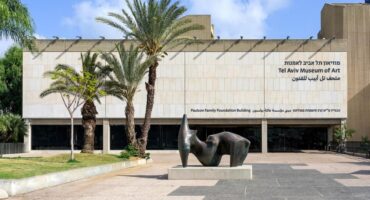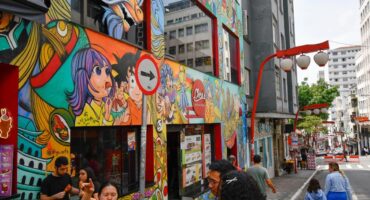The 25 km from Londrina, Geminiani Momesso Park houses relevant works of art in the city of Ibiporã, among them 60 sculptures and a pavilion dedicated to Angelo Venosa
The Parque Geminiani Momesso is an open-air art museum located in Ibiporã, to 25 kilometers from Londrina, where it already houses a pavilion in honor of the artist Angelo Venosa and sculptures by great names such as Emanoel Araújo, Gilberto Salvador, José Resende, Nicolas Vlavianos, Rubem Valentin and Victor Brecheret.
Businessperson, collector and supporter of the arts, Praying to Momesso, founded the Park and the non-profit organization Luciano Momesso Institute, who is responsible for managing the open-air museum. The Park will house 80% from the Orandi Momesso Collection, counting the last 500 years of Brazilian art history. Built over five decades, the important collection brings together around 5 thousand works by a great diversity of artists, in practically all periods of Brazilian art, including classics, pre-modern, modernists and contemporary. Often, works included in this set are donated to join the collection of Brazilian institutions, like MASP, the Pinacoteca do Estado de São Paulo and MAM.
The open-air museum is divided into pavilions, designed by Reinach Mendonça office, to house different segments and artists. Among the confirmed spaces are those destined for pre-cabraline funeral urns, craft objects, folk art, sacra, of original peoples, furniture, carrancas and a place for temporary exhibitions named after and honoring the painter Raphael Galvez.
All this artistic wealth is in an ecological paradise formed by an area 1.355 million square meters, of which 121 thousand are from virgin forest that meet the Tibagi River, one of the most important in the region. The area was donated by Orandi Momesso and is gradually being transformed into a cultural center with the project of important landscaper Rodolfo Geiser.
“Rainbow Space”, by Japanese-Brazilian artist Yutaka Toyota, was the most recently inaugurated sculpture in Geminiani Momesso Park. The monument “Espaço Arco-Íris” was originally produced to commemorate the Centenary of the Treaty of Friendship, Brazil-Japan Commerce and Navigation in 1995, when the first part was installed in Yokohama city, since then the work presupposed a corresponding half in Brazil. Now, Geminiani Momesso Park was the place chosen to house this symbol. “Completing this work is a dream I’ve always had., It has a very important meaning for me.”, diz Yutaka Toyota.
The sculpture refers to the history of these countries with trajectories marked by immigration and cultural exchange. The choice of the piece also seeks to value Brazil as a country that hosts the largest Japanese population outside of Japan and the state of Paraná as the second largest Japanese colony on Brazilian soil..
“One half is in Japan and the other, here in the park. The land of the rising sun and the red lands of northern Paraná will be connected. This landmark symbolizes the best of humanity: the Union", Affirms Orandi Momesso, businessman, collector, supporter of the arts and founder of Parque Geminiani Momesso. The inauguration of the work featured a butoh dance performance by artist Emilie Sugai and an official ceremony attended by collector Orandi Momesso, by artist Yutaka Toyota and authorities such as the Brazilian ambassador to Japan, Octavio Henrique Garcia Cortes; the Consul General of Japan in São Paulo, Ryosuke Getting; the mayor of Ibiporã, José Maria Ferreira, and representatives of the Ministry of Foreign Affairs and Itamaraty. The event also marked the presentation of the new open-air art museum, strengthening the state's position in the Brazilian cultural and artistic itinerary.
With a keen eye, Orandi Momesso created one of the most relevant art collections in Brazil. The Park stamps the legacy of this work of more than five decades by safeguarding the collection in public access and, in addition, dedicate a cultural and biodiverse space to your homeland. The collection's curation is aimed at Brazilian artists and those who live in Brazil and have a strong relationship with the country, como Yutaka Toyota, Brazilian naturalized in 1971.
The artist told, in your studio, the emotion that inspired the creation of the work. “I have always been interested in cosmic space since the beginning of my work. When I arrived in Brazil, I remember being enchanted by the landscape and the intense colors of nature and steel appeared in my work as a way of reflecting this new world”, declared. The monument is the result of a period of artistic production in Toyota, that in the decades of 80 and 90, explored industrial materials that became popular post-war, what is the case with metal. Segundo Yutaka, There was a lot of prejudice in Japan at the time towards non-traditional materials and criticism of his work stated that steel was kitchen material, unacceptable in works of art. Criticism reinforces the artist's pioneering spirit in expanding the canons of art and presenting new forms of artistic creation to the world.
Composed by 10 golden blocks – each one represents a decade – and a steel “handle” that resembles the hull of the ship that transported Japanese immigrants to Brazil, the tip of the sculpture installed in Japan is directed towards the geographical direction of Brazil and the tip of the sculpture inaugurated on Brazilian soil is directed towards the Asian country. The piece has 10 meters and weighs around three tons, two tons less than the original. Given your weight and height, installation takes place in stages, in which the steel parts will be transported separately and the painting completed on the spot.
Sign up to receive Event News
and the Universe of Arts first!
Despite the same appearance, versions adopt different materials. In Japan, the monument was built with stainless steel, while the new work in Brazil was made of carbon steel. At the end, both receive gold painting with polyurethane paint. The reason for the change is strategic: since carbon steel is more porous, there is greater adhesion of the paint layer and the consequent guarantee of durability of the piece that will be exposed to the open sky, susceptible to different climatic conditions.
Toyota will also develop a new version of the work for the Park “Vibration Space 2000”, which was commissioned for the collective exhibition “O Bardi dos Artistas”, held to honor Pietro Maria Bardi, and donated to the Pinacoteca de São Paulo.
Landscaping project by Rodolfo Geiser

Landscape design photos: flic.kr/s/aHBqjAZJUq
Regenerate and preserve flora, the soil and water of the region was the premise of the landscaping project for Geminiani Momesso Park designed by the firm Rodolfo Geiser Paisagismo e Meio Ambiente, formed by architect Christiane Ribeiro and agronomist Rodolfo Geiser. With more than one hundred thousand plantings already carried out, most trees, the proposal embraced the typical vegetation of the Atlantic Forest, valuing dozens of native species and adding a few specimens from other Brazilian and exotic biomes from other countries to create an exuberant and striking look.
The design elevates the public's experience by providing an environment of relationship between art and nature. There are five thousand linear meters of paved paths for Park visitors, with wider sections for the circulation of electric cars that guarantee accessibility for everyone, service accesses and fire protection setbacks. Along the route, arboreal massifs shelter visual surprises and receive, in your breaks, large sculptures and exhibition pavilions.
Geiser highlights the sensory experiences experienced in the Park: “Or smell, or touch, the audition, contemplation and taste. The visual beauty, the aroma of flowers and fruits, different climatic conditions, the touch of plants and the perception of their texture nuances, the action of the wind on the vegetation and even the flavor of wild fruits”. Along the way, visitors will also pass wooden decks, bridges and viewpoints that were designed to provide enjoyment among the landscape, the sculptures and pavilions. In addition to the natural hydrography of the region, the Rodolfo Geiser office project includes 33,7 thousand square meters of water mirrors that enhance the beauty of the ecological paradise that houses the open-air art museum of Paraná.






Magnificent open-air museum that always reopens in its dynamic artistic diversity, with beautiful works of art sensitively situated, in such a generously captivating nature and especially the union of cultures between Brazil and Japan!…They benefit from this great institution; people, artists, the city of Ibiporã, Paraná, Brazil and the world!!!…